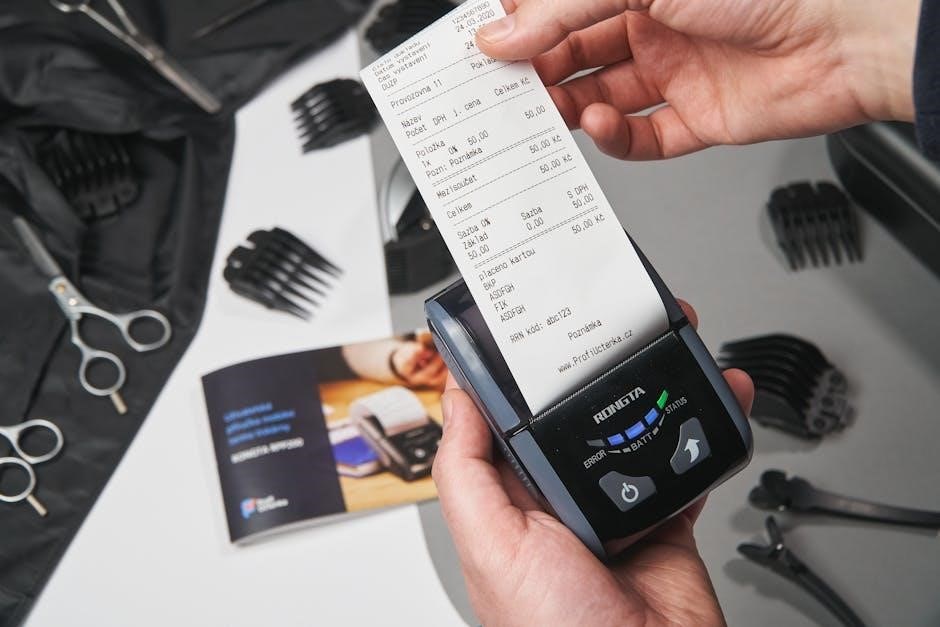The Oklahoma Commercial Driver License Manual is a comprehensive guide for truck and bus drivers, detailing CDL requirements, testing procedures, and essential driving rules and safety protocols.
Overview of the CDL Manual
The Oklahoma Commercial Driver License Manual is a detailed resource designed to help individuals prepare for the CDL testing process. It covers essential topics such as CDL classes, endorsements, medical requirements, and disqualifications. The manual also provides information on the knowledge and skills tests, including pre-trip inspections, basic vehicle control, and on-road driving evaluations. Additionally, it outlines federal and state qualifications for commercial drivers and offers insights into recent updates to CDL regulations. This guide is indispensable for both new applicants and experienced drivers seeking to renew or upgrade their licenses. It is available for free download or online viewing for convenience.
Federal and State Qualifications for Commercial Motor Vehicle Drivers
The Oklahoma Commercial Driver License Manual outlines specific federal and state qualifications for commercial drivers. Federally, drivers must be at least 21 years old, pass a medical examination, and undergo criminal background checks. Oklahoma requires proof of residency and a valid Social Security number. Senate Bill 20 mandates English proficiency testing for CDL holders operating in the state. These qualifications ensure public safety and compliance with federal regulations. Drivers must meet both federal and state standards to operate commercial vehicles legally in Oklahoma. The manual provides detailed guidance on these requirements, helping applicants understand the necessary steps to qualify for a CDL.
Recent Updates to the Oklahoma CDL Manual
The 2025 Oklahoma CDL Manual includes new federal and state regulations, such as enhanced English proficiency requirements for commercial drivers under Senate Bill 20. Updates also cover revised medical certification processes and stricter disqualification criteria for serious offenses. The manual now emphasizes tanker and hazmat endorsements, reflecting industry safety standards. Additionally, it includes updated sections on pre-trip inspections and on-road driving tests. Drivers are encouraged to download the latest version to stay compliant with current laws and ensure they meet all federal and state qualifications. These updates aim to improve road safety and align Oklahoma’s CDL program with national guidelines.

Eligibility Requirements for a Commercial Driver License in Oklahoma
The Oklahoma CDL Manual outlines the essential requirements for eligibility, ensuring drivers meet federal and state standards, including age, residency, medical certification, and background checks.
Age Requirements for CDL Applicants
The Oklahoma CDL Manual specifies that applicants must be at least 21 years old to operate a commercial vehicle across state lines or transport hazardous materials. For intrastate commerce, drivers can apply at 18 years old, though they must meet specific state requirements. It is crucial for applicants to verify their age eligibility based on the type of CDL they are pursuing to ensure compliance with both federal and state regulations. Proper age verification is necessary during the application process.
Residency and Proof of Domicile in Oklahoma
Oklahoma CDL applicants must provide proof of residency and domicile within the state. Acceptable documents include a valid Oklahoma driver’s license, vehicle registration, or utility bills. This requirement ensures applicants are legal residents, meeting federal and state guidelines. Proper documentation is essential for processing the CDL application. Residency verification is a mandatory step to obtain a commercial driver’s license in Oklahoma, confirming the applicant’s lawful domicile within the state.
Medical Certification for Commercial Drivers
Commercial drivers in Oklahoma must meet strict medical standards to ensure road safety. The Federal Motor Carrier Safety Administration (FMCSA) requires CDL holders to undergo a physical examination by a certified medical examiner. The exam assesses vision, hearing, blood pressure, and overall health to determine fitness for driving a commercial vehicle. Drivers must carry a valid medical certification card and submit it to the Oklahoma Department of Public Safety. Failure to comply with medical certification requirements can result in loss of CDL privileges. The manual provides detailed information on the medical certification process, including required exams and how to maintain compliance.
Background Checks and Criminal History Requirements
Obtaining a Commercial Driver License (CDL) in Oklahoma requires passing a thorough background check. This process ensures public safety by identifying individuals with disqualifying criminal histories. The Oklahoma Department of Public Safety (DPS) reviews both state and federal records for offenses such as drunken driving, reckless driving, and felony convictions. Certain crimes, like those involving drugs or violence, may permanently disqualify an applicant. Temporary disqualifications apply for offenses like DUI, with reinstatement possible after a specified period. Applicants must disclose all criminal history, and failure to do so can result in license denial. The manual outlines specific offenses and their impact on CDL eligibility.

Classes of Commercial Driver Licenses
Oklahoma offers three CDL classes: Class A for combination vehicles, Class B for heavy straight vehicles, and Class C for small passenger vehicles and hazardous materials.
Class A CDL: Combination Vehicles
A Class A CDL in Oklahoma is required to operate combination vehicles with a GVWR of 26,001 pounds or more, including a towed unit weighing over 10,000 pounds. This license allows drivers to operate tractor-trailers, semi-trucks, and other large commercial vehicles. Applicants must be at least 21 years old and pass both the knowledge and skills tests. The manual emphasizes safety protocols, pre-trip inspections, and handling large vehicles. It also covers endorsements for specialized cargo, ensuring drivers are prepared for various scenarios on the road. This section is crucial for aspiring truck drivers seeking to obtain a Class A CDL in Oklahoma.
Class B CDL: Heavy Straight Vehicles
A Class B CDL in Oklahoma is designed for operating heavy straight vehicles with a Gross Vehicle Weight Rating (GVWR) of 26,001 pounds or more, including a trailer that does not require a separate axle. This license is ideal for drivers of large buses, dump trucks, and box trucks. Applicants must be at least 21 years old and pass both the knowledge and skills tests. The manual highlights safety practices, vehicle inspection procedures, and maneuvering techniques specific to these vehicles. It also outlines endorsement requirements for specialized cargo or passenger transportation, ensuring drivers are well-prepared for the challenges of operating heavy straight vehicles in Oklahoma.
Class C CDL: Small Passenger Vehicles
A Class C CDL in Oklahoma is required to operate small passenger vehicles designed to transport 16 or more passengers, including the driver, or for vehicles transporting hazardous materials that require a placard, regardless of weight. This license is ideal for drivers of small buses, shuttle services, and passenger vans. The gross vehicle weight rating (GVWR) for Class C vehicles is less than 26,001 pounds. Applicants must meet specific eligibility criteria and pass the appropriate knowledge and skills tests. The manual emphasizes safe passenger transport practices, vehicle inspection, and emergency procedures; Endorsements may be needed for hazardous materials or passenger transport.

The CDL Application Process in Oklahoma
The CDL application process in Oklahoma involves completing forms, submitting required documents, paying fees, and passing mandatory knowledge and skills tests for the desired license class.
Steps to Apply for a Commercial Driver License
To apply for a Commercial Driver License in Oklahoma, follow these steps: Determine your eligibility, gather required documents, and complete the application form. Submit the application to the Oklahoma Department of Public Safety, pay the applicable fees, and pass the vision test. Next, take the mandatory knowledge tests based on your desired CDL class and endorsements. Once you pass, schedule and complete the skills test, which includes a pre-trip inspection, basic vehicle control, and an on-road driving test. Upon successful completion, you will be issued your CDL. The official manual provides detailed guidance for each step of the process.
Required Documents for CDL Application
To apply for a Commercial Driver License in Oklahoma, you must submit specific documents. These include proof of identity, such as a valid passport or birth certificate, and proof of residency, like a utility bill or lease agreement. You must also provide documentation of domicile in Oklahoma. Additionally, a valid Medical Examiner’s Certificate and a completed Medical Examination Report are required for medical certification. You will also need to present your Social Security card or another approved document to verify your Social Security number. Ensure all documents are current and authenticated to avoid delays in processing your CDL application.
CDL Application Fees and Payment Methods
The cost of applying for a Commercial Driver License in Oklahoma varies based on the class of license and endorsements. The base fee for a Class A, B, or C CDL is typically around $75 to $100 for a 4-year license. Additional fees may apply for endorsements, such as Hazmat or Tanker, which range from $10 to $30 each. Payment methods accepted include cash, credit/debit cards, and checks. It’s important to verify the exact fees and payment options with the Oklahoma Department of Public Safety before submitting your application to ensure a smooth process.

Preparing for the CDL Knowledge Tests
The official Oklahoma CDL manual and additional study guides provide essential information for the written tests and endorsements. Utilize practice tests and online resources to ensure readiness.
Overview of the CDL Written Knowledge Tests
The CDL written knowledge tests assess a candidate’s understanding of commercial driving laws, safety protocols, and vehicle operation. The general knowledge test covers essential topics such as road signs, traffic laws, and safe driving practices. Additional tests are required for specific endorsements, like hazardous materials or passenger vehicles. The tests are designed to ensure drivers can operate safely and professionally. Preparation materials, including the Oklahoma CDL manual and practice tests, are available to help applicants succeed. Passing these tests is a critical step toward obtaining a commercial driver license in Oklahoma.
Study Materials and Resources for CDL Preparation
The Oklahoma CDL manual is the primary study resource, offering detailed information on driving laws, safety protocols, and vehicle operation. Practice tests are available online to help applicants assess their knowledge and identify areas for improvement. Additionally, interactive study guides and courses provide tailored support, including audio learning options and AI-driven assistance. These resources ensure comprehensive preparation for both the written and practical exams. Utilizing these materials effectively enhances understanding and confidence, making it easier to pass the CDL tests and obtain the desired endorsements. Mastering the manual and supplementary resources is key to success in the CDL application process.
Practice Tests for CDL Applicants
Oklahoma CDL applicants can benefit from practice tests designed to mirror the actual exam format. These tests include 148 multiple-choice questions covering essential topics such as driving laws, safety protocols, and vehicle operation. Practice tests are available online or as printable resources, allowing applicants to prepare at their convenience. They provide immediate feedback and score tracking, helping identify areas needing improvement. Regular use of these tests enhances familiarity with the exam structure and content, boosting confidence and readiness. By leveraging these tools, applicants can ensure they are well-prepared for the written and practical exams required to obtain their CDL.

CDL Road Skills Testing
CDL road skills testing evaluates applicants’ ability to operate commercial vehicles safely. Tests include pre-trip inspections, basic vehicle control maneuvers, and on-road driving assessments to ensure proficiency.
Pre-Trip Inspection Requirements
A pre-trip inspection is mandatory for CDL applicants to ensure vehicle safety. Drivers must check essential components like brakes, tires, lights, mirrors, and hydraulic systems. They must also verify the condition of the cargo securement devices and ensure all safety equipment is functioning properly. The inspection process is detailed in the Oklahoma CDL manual, outlining specific steps to follow. Proper documentation of findings is required, and any defects must be reported before operating the vehicle. This step ensures compliance with federal and state regulations, promoting road safety and reducing the risk of accidents during the road skills test.
Basic Vehicle Control Skills Test
The Basic Vehicle Control Skills Test evaluates a driver’s ability to maneuver a commercial vehicle safely and accurately. This test includes exercises like forward and reverse straight-line driving, offset back-up, and alley docking. Applicants must demonstrate control while navigating through cones or other markers, showcasing their precision and coordination. The test assesses how well they can align the vehicle, maintain direction, and avoid obstacles. Proper use of mirrors and awareness of surroundings are crucial. The Oklahoma CDL manual provides detailed instructions on each maneuver, emphasizing the importance of smooth and deliberate movements. Mastery of these skills is essential for passing the road test.
On-Road Driving Test
The On-Road Driving Test evaluates a driver’s ability to operate a commercial vehicle safely in real-world traffic conditions. Applicants must demonstrate proficiency in merging, turning, braking, and maintaining proper lane position. The test also assesses adherence to traffic laws, such as speed limits and right-of-way rules. Drivers are scored on their ability to navigate through urban and rural routes, showing smooth transitions and awareness of surrounding vehicles. The Oklahoma CDL manual outlines specific criteria examiners use, emphasizing safe driving practices and vehicle control. Successful completion of this test is the final step before obtaining a Commercial Driver License in Oklahoma.

Endorsements and Special Certifications
Endorsements and special certifications enhance a CDL, allowing drivers to operate specific vehicles like hazardous material transports, tankers, and passenger or school buses, requiring additional testing and qualifications.
Hazmat Endorsement Requirements
To obtain a Hazardous Materials (Hazmat) endorsement in Oklahoma, applicants must undergo a Transportation Security Administration (TSA) background check. This endorsement is required for transporting hazardous materials. Applicants must be U.S. citizens or lawful residents and pass a TSA screening. Additionally, they must complete a written knowledge test covering safe handling, transportation, and regulations of hazardous materials. The endorsement is renewable every 5 years, and drivers must maintain a valid Medical Examiner’s Certificate. This ensures compliance with federal and state safety standards for hazmat transportation. The process is detailed in the official Oklahoma CDL manual.
Tanker Vehicle Endorsement
The Tanker Vehicle Endorsement is required for drivers operating vehicles designed to transport liquids or gases in bulk. To obtain this endorsement, applicants must pass a specialized knowledge test covering tanker operations, safety measures, and cargo handling. A valid Class A CDL is typically required, as tankers often involve combination vehicles. This endorsement ensures drivers are equipped to manage the unique challenges of hauling liquids, including preventing accidents and cargo loss. The endorsement is optional but essential for those seeking to drive tankers. It emphasizes safety and precision in handling large liquid loads, ensuring compliance with federal and state regulations.
Passenger and School Bus Endorsements
The Passenger and School Bus Endorsements are required for drivers transporting passengers, including school children. These endorsements demand a Class B or Class C CDL and involve rigorous testing. The Passenger Endorsement ensures competence in safely transporting large groups of people, while the School Bus Endorsement requires additional training and a background check. Both endorsements involve specialized knowledge tests and skills assessments, focusing on safety, emergency procedures, and vehicle inspection. Applicants must demonstrate ability to handle unique challenges, such as managing passenger behavior and ensuring safe pick-up/drop-off procedures. These endorsements are crucial for public safety and require continued compliance with federal and state regulations to maintain eligibility.

Medical Requirements for CDL Holders
CDL holders must meet federal medical standards, requiring certification through the FMCSA Medical Certification Process. Submitting medical cards to the Oklahoma Department of Public Safety is mandatory. Drivers must maintain valid certification to avoid license suspension.
FMCSA Medical Certification Process
The FMCSA Medical Certification Process ensures CDL holders meet federal health standards. Drivers must undergo a physical exam by an FMCSA-approved medical examiner. The exam includes vision, blood pressure, and urinalysis tests. Certification is valid for 1-2 years, depending on health conditions. Drivers must submit a completed Medical Examiner’s Certificate to the Oklahoma Department of Public Safety. Failure to maintain valid certification results in CDL suspension. The process ensures road safety by verifying drivers’ physical fitness for operating commercial vehicles. Regular recertification is required to maintain eligibility. This process aligns with federal regulations and Oklahoma state requirements for commercial driver licensing.
Submitting Medical Cards to the Oklahoma Department of Public Safety
CDL holders must submit a valid Medical Examiner’s Certificate to the Oklahoma Department of Public Safety (DPS) to maintain their commercial driver license. The medical card, issued by an FMCSA-certified medical examiner, must be submitted within 15 days of the exam. Drivers can upload the document online via the DPS portal, mail it to the specified address, or fax it. In-person submission is also accepted at local DPS offices. Failure to submit the medical card results in CDL suspension. Only original or certified copies are accepted; photocopies are not valid. This ensures compliance with federal and state medical certification requirements for commercial drivers;

CDL Disqualifications and Suspensions
CDL disqualifications and suspensions occur due to severe offenses such as DUI, reckless driving, and major traffic violations, significantly impacting a driver’s commercial driving career.
Offenses Leading to CDL Disqualification
Various offenses can lead to CDL disqualification, including serious traffic violations, such as speeding, reckless driving, or DUI, and criminal offenses like manslaughter or hit-and-run incidents. Additionally, Senate Bill 20 introduces English proficiency requirements for CDL holders, potentially leading to disqualification if not met. These offenses significantly impact a driver’s commercial driving career, emphasizing the importance of adhering to traffic laws and maintaining proper documentation.
Duration of Disqualifications and Reinstatement Process
CDL disqualifications in Oklahoma vary based on the severity of the offense. Minor violations may result in a 60-day suspension, while more serious offenses, such as DUI or reckless driving, can lead to a 1-year disqualification. Felonies or manslaughter convictions may result in a 3-year disqualification. To reinstate a CDL, drivers must wait the mandated period, pay reinstatement fees, and possibly retake CDL tests. Additionally, failing to meet English proficiency requirements under Senate Bill 20 could extend disqualification periods. Understanding these timelines and processes is crucial for maintaining commercial driving privileges.

Additional Resources for CDL Applicants
The Oklahoma CDL manual offers additional resources, including downloadable PDFs, interactive study guides, practice tests, and FAQs. These tools help applicants prepare effectively for their exams.
Downloading the Official Oklahoma CDL Manual
The official Oklahoma CDL manual is available for free download as a PDF from the Oklahoma Department of Public Safety website. Applicants can easily access the manual online or print it for convenience. The manual is regularly updated, such as the 2025 edition, to reflect the latest regulations and requirements. It includes detailed sections on CDL classes, medical certifications, and testing procedures. Additionally, the manual provides sample test questions and study guides to help applicants prepare for their exams. By downloading the manual, aspiring commercial drivers can ensure they have all the necessary information to pass their tests and obtain their license efficiently.
CDL Test Preparation Guides and Courses
Enhance your CDL preparation with Oklahoma’s free CDL handbook and interactive study guides. The manual offers comprehensive resources, including practice tests, audio guides, and AI chat support for personalized learning. It covers essential topics like driving rules, safety protocols, and road skills. Applicants can also access online courses tailored to specific CDL classes, ensuring they are well-prepared for both written and road tests. These resources are designed to help applicants master the material efficiently, increasing their chances of passing the CDL exam on the first attempt and becoming successful commercial drivers in Oklahoma.
FAQs About the CDL Application and Testing Process
Frequently asked questions about the CDL application and testing process in Oklahoma include how to apply, where to obtain the manual, and medical card submission requirements. Applicants often inquire about test preparation resources and the types of CDLs available. Questions also arise about English proficiency requirements for commercial drivers, as proposed by Senate Bill 20. Additionally, many ask about the duration of disqualifications and the reinstatement process. These FAQs provide clarity on eligibility, testing procedures, and endorsements, ensuring applicants are well-informed and prepared for the CDL process in Oklahoma.
